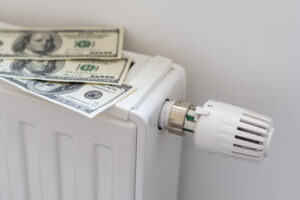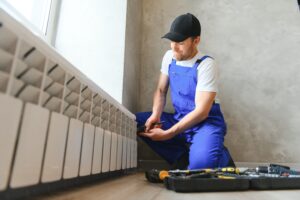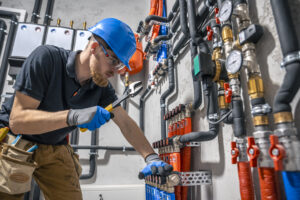In today’s world, where environmental consciousness is on the rise, homeowners and businesses are constantly seeking ways to reduce their carbon footprint. One area that often goes unnoticed is the HVAC system, which plays a significant role in energy consumption. Sustainable HVAC practices offer a pathway to not only a greener home but also substantial economic benefits. In this blog post, we will explore the importance of sustainable HVAC practices and provide practical tips for making your heating and cooling systems more eco-friendly. Whether you’re a homeowner or a business owner, this guide is tailored to help you understand the benefits and implementation of sustainable HVAC solutions.
Understanding the Environmental Impact of Traditional HVAC Systems
Traditional HVAC systems are notorious for their environmental impact. They consume a staggering amount of energy, contributing to high electricity bills and increased greenhouse gas emissions. For instance, according to the U.S. Energy Information Administration, heating and cooling account for nearly 40% of a building’s energy use. This makes HVAC systems one of the largest contributors to energy consumption. Furthermore, the refrigerants used in conventional systems can have a detrimental effect on the ozone layer. It’s imperative to recognize the environmental damage caused by outdated HVAC systems to motivate change.
The environmental consequences of traditional HVAC systems are far-reaching. These systems rely heavily on fossil fuels, leading to the depletion of natural resources. The extraction and burning of these fuels release harmful pollutants into the atmosphere, exacerbating climate change. Additionally, older HVAC models are often inefficient, requiring more energy to achieve desired temperatures. This inefficiency contributes to the overall energy crisis and places an unnecessary burden on power grids.
Addressing the environmental impact of traditional HVAC systems is crucial for achieving sustainability goals. Transitioning to greener alternatives can significantly reduce carbon emissions and help mitigate climate change. By understanding the magnitude of the problem, homeowners and businesses can make informed decisions about their HVAC systems and take steps towards a greener future.
What Are Sustainable HVAC Practices?
Sustainable HVAC practices encompass a range of strategies aimed at reducing energy consumption and minimizing environmental harm. One of the most effective approaches is upgrading to energy-efficient HVAC systems. Modern systems, such as heat pumps and variable refrigerant flow (VRF) units, are designed to operate with greater efficiency, resulting in reduced energy usage. These systems often come with advanced features like programmable thermostats and zoning capabilities, allowing for precise temperature control and optimized energy consumption.
Another sustainable HVAC practice gaining popularity is the use of smart thermostats. These devices enable users to monitor and control their HVAC systems remotely, optimizing energy usage based on real-time data. Smart thermostats can learn user preferences and adjust settings accordingly, ensuring that energy is not wasted when no one is at home or in the office. Additionally, they provide insights into energy consumption patterns, empowering users to make informed decisions about their HVAC settings.
Geothermal heating is another sustainable HVAC practice that harnesses the earth’s natural heat to warm and cool spaces. Geothermal systems utilize underground loops to transfer heat, offering an environmentally friendly alternative to traditional heating methods. These systems are highly efficient, providing a consistent and comfortable indoor climate while significantly reducing energy consumption. Although the initial installation cost may be higher, the long-term savings and environmental benefits make geothermal heating a worthwhile investment.
Case Studies Showcasing Success in Sustainable HVAC Solutions
Real-life examples demonstrate the effectiveness and feasibility of sustainable HVAC solutions. Take the case of a residential homeowner who decided to upgrade their HVAC system to a high-efficiency heat pump. By doing so, they were able to reduce their energy consumption by 30% and cut their utility bills significantly. The homeowner also installed a smart thermostat, allowing them to monitor and adjust their HVAC settings remotely. These changes not only saved money but also contributed to their commitment to reducing their carbon footprint.
Businesses, too, are reaping the rewards of sustainable HVAC practices. A commercial building in a metropolitan area implemented a comprehensive energy management system that included energy-efficient HVAC upgrades. By integrating smart controls and sensors, they achieved a 40% reduction in energy consumption. The building’s occupants noticed improved comfort levels, and the business saw a substantial decrease in operating costs. This case study exemplifies the financial and environmental benefits that can be achieved through sustainable HVAC solutions.
Another remarkable example is a school district that adopted geothermal heating across its campuses. By tapping into the earth’s natural energy, the district reduced its reliance on fossil fuels and lowered its energy bills. The geothermal systems provided consistent heating and cooling, ensuring a comfortable learning environment for students. Beyond the financial savings, the district took pride in its commitment to sustainability and set an example for other educational institutions.
Practical Tips for Homeowners and Businesses to Achieve Sustainability
Transitioning to sustainable HVAC systems doesn’t have to be daunting. By following a few practical tips, homeowners and businesses can make significant strides toward achieving sustainability goals. First and foremost, regular maintenance is crucial. Cleaning or replacing air filters, checking ductwork for leaks, and scheduling professional inspections ensure that HVAC systems operate efficiently. Routine maintenance not only extends the lifespan of the equipment but also reduces energy consumption.
Another tip is to optimize temperature settings. Keeping indoor temperatures within a moderate range reduces the workload on HVAC systems and lowers energy usage. During the summer, setting the thermostat a few degrees higher and utilizing ceiling fans can significantly reduce cooling costs. In colder months, wearing an extra layer and setting the thermostat a couple of degrees lower can save energy without compromising comfort.
Sealing and insulating the building envelope can make a substantial difference in energy efficiency. Proper insulation prevents heat loss in the winter and heat gain in the summer, reducing the strain on HVAC systems. Ensuring that windows and doors are properly sealed also prevents drafts and minimizes energy waste. By addressing these factors, homeowners and businesses can create a more comfortable and sustainable indoor environment.
Financial and Environmental Benefits of Sustainable HVAC Practices
Adopting sustainable HVAC practices offers a multitude of benefits, both financially and environmentally. From a financial perspective, investing in energy-efficient HVAC systems leads to long-term cost savings. Although the initial installation costs may be higher, the reduced energy consumption results in lower utility bills. Over time, these savings offset the upfront expenses, providing a favorable return on investment.
In addition to cost savings, sustainable HVAC practices contribute to environmental preservation. By reducing energy consumption, homeowners and businesses can significantly decrease their carbon footprint. This reduction in greenhouse gas emissions helps combat climate change and promotes a healthier planet for future generations. Sustainable HVAC practices also align with government incentives and regulations, offering potential tax credits and rebates to further offset costs.
Furthermore, sustainable HVAC practices enhance the overall comfort and indoor air quality of a space. Energy-efficient systems provide consistent temperatures, eliminate hot or cold spots, and reduce noise levels. Improved air circulation and filtration lead to cleaner indoor air, reducing allergens and pollutants. These benefits create a healthier living and working environment, enhancing the well-being of occupants.
Exploring Future Trends in Green HVAC Technology
The future of HVAC technology holds exciting possibilities for sustainable solutions. One emerging trend is the integration of artificial intelligence (AI) and machine learning into HVAC systems. AI algorithms can analyze data from sensors and adjust system settings in real time, optimizing energy usage and improving efficiency. These intelligent systems can adapt to changing weather conditions and individual preferences, providing personalized comfort while minimizing energy waste.
Another trend gaining traction is the use of renewable energy sources to power HVAC systems. Solar-powered HVAC systems are becoming increasingly viable, utilizing solar panels to generate electricity for heating, cooling, and ventilation. This approach not only reduces reliance on fossil fuels but also takes advantage of abundant and clean energy. As solar technology continues to advance, the cost and efficiency of solar-powered HVAC systems are expected to improve, making them a viable option for homeowners and businesses.
Furthermore, advancements in smart home technology are revolutionizing HVAC systems. Internet of Things (IoT) devices enable seamless integration and control of HVAC systems through smartphones or voice assistants. Homeowners can monitor and adjust temperature settings remotely, receive real-time energy usage reports, and receive maintenance alerts. These innovations empower users to actively manage their energy consumption and optimize their HVAC systems for maximum efficiency.






